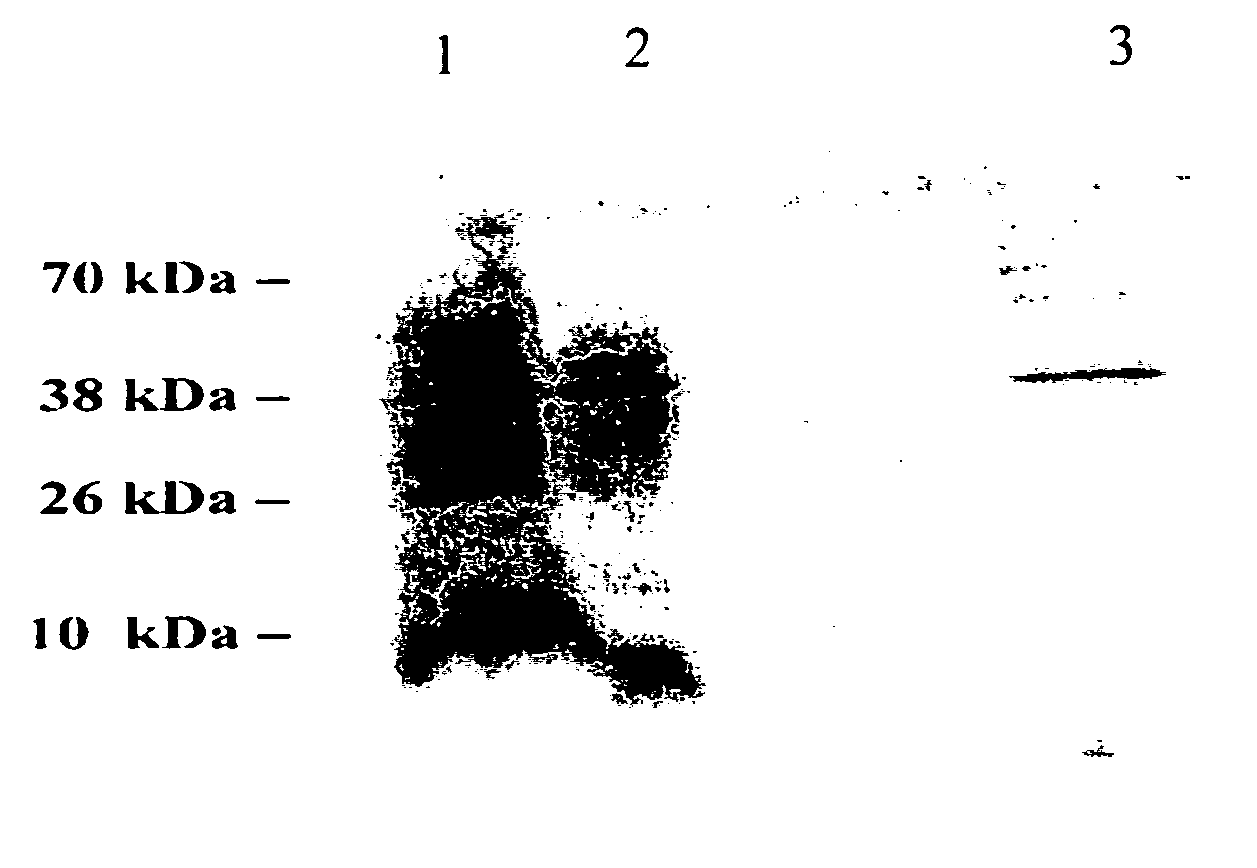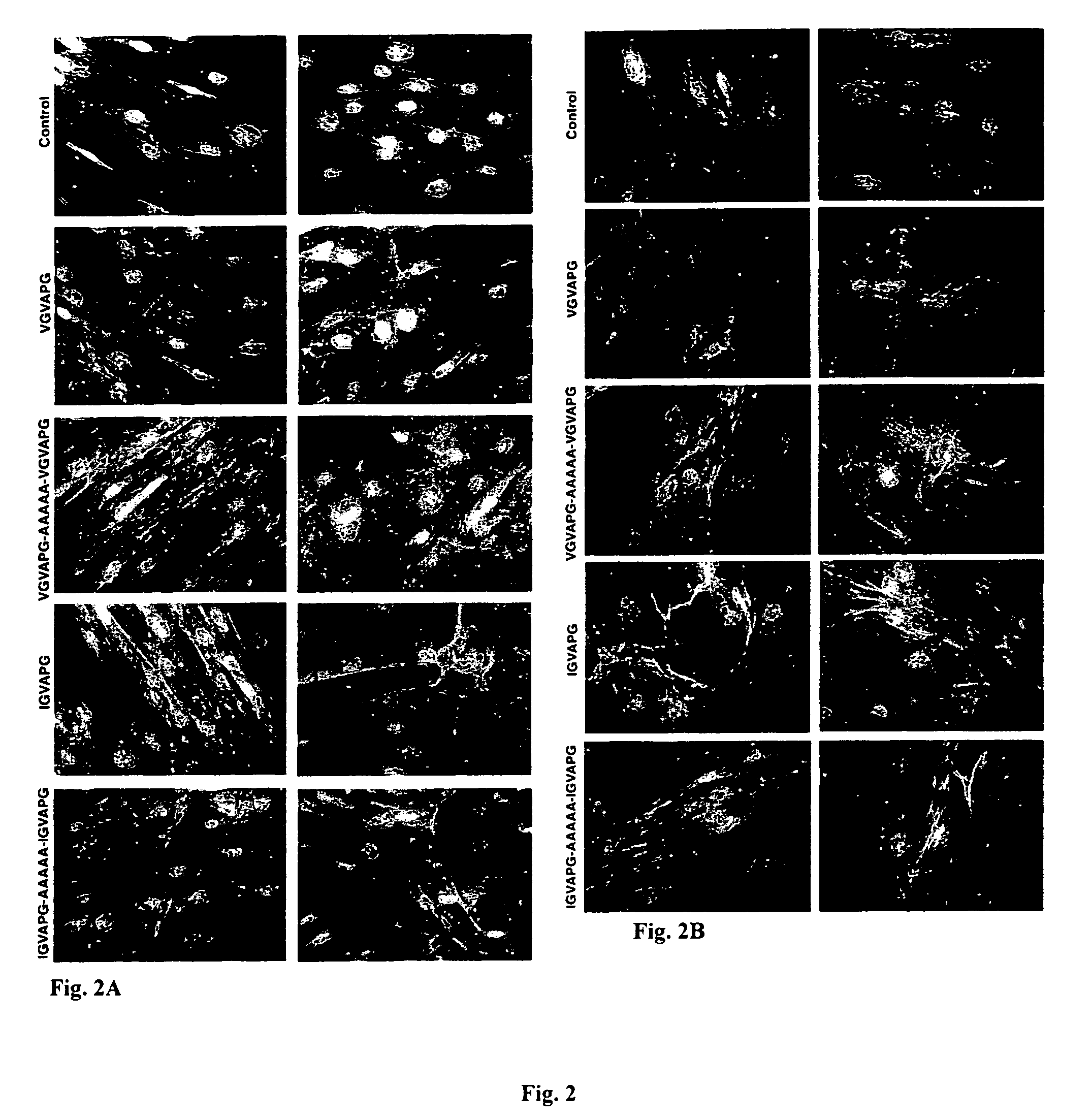Plant-derived elastin binding protein ligands and methods of using the same
a technology of plant-derived elastin and binding protein, which is applied in the direction of peptide/protein ingredients, peptide sources, drug compositions, etc., can solve the problems of age-related wrinkles, essentially irreversible formation of wrinkles, and loss of dermal fibroblasts ability, so as to increase the production of elastic fibers
- Summary
- Abstract
- Description
- Claims
- Application Information
AI Technical Summary
Benefits of technology
Problems solved by technology
Method used
Image
Examples
example 1
[0102]Reagents. Soluble and insoluble rice bran were obtained from CGS Group, Inc. VGVAPG was obtained from Sigma (St. Louis, Mo.). EBPL-1 (VGVAPGAAAAAVGVAPG) (SEQ ID NO. 10), EBPL-2 (IGVAPG) (SEQ ID NO. 13) and EBPL-3 (IGVAPGAAAAAIGVAPG) (SEQ ID NO. 14) were organically synthesized according to our design by EZBIOLAB, Inc. All peptides were synthesized at 95% purity.
[0103]Preparation of Chemically Digested Soluble Rice Bran. One Gram of Soluble Rice Bran (Nutri Select Soluble-Nutri Rice CDG Group Inc.) was suspended in 40 ml of 1M NaOH diluted in 80% ethanol and incubated for one hour. The preparation was then centrifuged at 4000 rpm for 10 min, the pellet was re-suspended in 20 ml of distilled water, dialyzed (MWCO 2000) overnight against distilled water and than lyophilized. The product was then re-suspended in 5 ml of 0.25M oxalic acid and boiled for 1 hour. After centrifugation at 4000 rpm for 10 min the supernatant No 1 was collected and remaining pellet was re-suspended again...
example 2
[0112]Production of new elastic fibers was also monitored by metabolic labeling tropoeelastin produced by cultured fibroblasts and its subsequent incorporation into insoluble elastin, the major component of elastic fibers. Fibroblasts were densely plated (50×105 / dish) and grown to confluency in 10 cm cell culture dishes in quadruplicate. 20 μCi of [3H]-valine was added to each dish along with fresh media. Cultures were then incubated for 72 hours and insoluble elastin was assessed separately in each culture. After media was removed, the cell layers and deposited extracellular matrix were scraped in 0.1N NaOH, sedimented by centrifugation, and boiled in 0.5 mL of 0.1N NaOH for 45 minutes to solubilize all matrix components except elastin. The resulting pellets containing the insoluble elastin were then solubilized by boiling in 200 μL of 5.7 N HCl for 1 hour and the aliquots were mixed with scintillation fluid and counted.
[0113]FIG. 3 shows the quantitative assessment of [3H]-Valine ...
example 3
[0115]Immunocytochemistry of 7 day-old fibroblast cultures with anti-tropoelastin antibody demonstrated that dermal fibroblasts derived from a female patient with stretch marks produced significantly more elastic fibers when treated with the chemically digested rice bran (CDRB). The CDRB-treated fibroblasts also demonstrated more immuno-detectable tropoelastin in their intracellular Golgi compartment than the untreated control fibroblast.
[0116]Preliminary immunocharacterization of CDRB showed immunoreactivity with a polyclonal elastin antibody, suggesting that CDRB may contain similar secondary structures found in mammalian elastin.
[0117]Data demonstrates that the rice-based peptides are much more (>500%) potent elastogenic inducers than ProK-60. This was confirmed through indirect immuno-fluorescence. Results were confirmed with Northern Blots and metabolic labeling of insoluble elastin (data not shown).
PUM
| Property | Measurement | Unit |
|---|---|---|
| weight percent | aaaaa | aaaaa |
| area | aaaaa | aaaaa |
| elastic | aaaaa | aaaaa |
Abstract
Description
Claims
Application Information
 Login to View More
Login to View More - R&D
- Intellectual Property
- Life Sciences
- Materials
- Tech Scout
- Unparalleled Data Quality
- Higher Quality Content
- 60% Fewer Hallucinations
Browse by: Latest US Patents, China's latest patents, Technical Efficacy Thesaurus, Application Domain, Technology Topic, Popular Technical Reports.
© 2025 PatSnap. All rights reserved.Legal|Privacy policy|Modern Slavery Act Transparency Statement|Sitemap|About US| Contact US: help@patsnap.com



